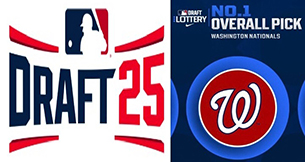Rizzo spent $40 million so far on new acquisitions, but why didn’t he spend some of that on a top free agent?

Was it all about the money — or was it about how the money was spent? Another local writer questioned why the Washington Nationals did not sign a big free agent. We will discuss this in detail.
So why didn’t the Nats sign a top free agent? If you believe general manager Mike Rizzo, he decided not to sign players with QOs attached to them as well as he made the point that they did not block any prospects. He knew what his budget was in early December. We don’t know that exact number — but suffice it to say that it was at least $40 million because that is what has been spent, so far, on new additions to the roster.
The calendar has turned to February, and Opening Day is less than 55-days away with Spring Training camp opening 11-days from today. Time is getting short, and the goals that manager Dave Martinez set for his 2025 roster have not been fully achieved. Martinez said at the Winter Meetings, “We’re definitely looking for corner [infield] guys, we really are. … We’re definitely looking for some power bats at both corner spots … We’ll see what transpires.“
While Martinez got his first base corner guy, he didn’t get the ‘hot corner’ guy known as the third baseman, yet, anyway. There were the reports that the Nats tried to sign Gleyber Torres contingent on his agreement to switch his position to third base which he rejected.
Ultimately, decisions were made on where the budget would be spent, and Rizzo went for depth and quantity instead of trusting his internal roster that he had at the start of the Winter Meetings. Basically he went outside for help instead of handing four starting rotation spots to MacKenzie Gore, Jake Irvin, DJ Herz, and Mitchell Parker. Yes, they needed one additional starter, and Rizzo brought back Trevor Williams plus two new starters via free agency.
THE MATH
Rizzo spent over $20 million on these players: RHP Michael Soroka ($9MM), DH Josh Bell ($6MM), LHP Shinnosuke Ogasawara ($2.1MM with posting fee), UT Amed Rosario ($2MM), and Rule-5 reliever Evan Reifert ($860K with the Rule-5 fee). Were they all needed? That could have been $20 million to spend elsewhere.
Rizzo spent around $21 million on these players: 1B Nathaniel Lowe ($10.3MM to $11.1MM salary), RHP Williams ($7.0MM), reliever Jorge Lopez ($3.0MM).
THE ALTERNATIVE THINKING
But if Rizzo signed a QO’d player like Alex Bregman, most likely, for around a $25MM AAV for seven seasons that would have put the team at $46 million in new payroll this year. Okay, I exceeded the current $40 million budget by a little. But I also believe that the payoff by creating the excitement around Bregman would have paid for that $6 million at the turnstiles quite easily.
Personally, I think this was a swing and miss by the organization. This was an opportunity to send a clear message to the fan base and media that would have signaled that the rebuild was over, and winning was a priority.
THE REASONING
Now if we take Rizzo at his word, the issue was not signing long-term deals, rather the issue was that the QO’d players and the penalties associated with signing them as well as potentially blocking prospects was the reason why he did not sign a player like Bregman.
Rizzo’s strategy will be analyzed into the future when we see how his 2025 second round draft pick (yet to be picked), that he did not forfeit by signing a QO’d player, does in his career. That’s tangible. We can track that when we know who that drafted player is in mid-July. Here was Rizzo’s full reasoning:
“Knowing where we’re at right now, the qualifying offer [would result in] losing a high draft pick was something that we took into account, and losing international money. We took [all of that] into account when we made decisions about signing [QO’d] free agents.”
— Rizzo said last weekend
“I think that we’ve improved our club, and at the same time, we haven’t blocked any prospects.”
Yes, the club has been improved, by a few wins. Rizzo spent money on depth in the starting pitching, and bringing in Bell. However, all acquisitions are for the short-term which keeps the roster free of long-term commitments beyond Keibert Ruiz. That, of course, bodes well for the future in that respect, and could allow Rizzo to extend contracts on some of his current players. My plan would have stuck the Nationals with Bregman’s $25 million per year through 2031. That is a big difference.
DIFFERENT ROUTES TAKEN
On a bumpy road, my route would have been to go with Williams, Gore, Irvin, Herz, and Parker as my starting rotation with Cade Cavalli, Brad Lord, Jackson Rutledge, Andrew Alvarez, and Joan Adon as the Triple-A depth. And instead of Bell at DH, I would have had Jose Tena and Andres Chaparro. For bench utility, I would have stuck with Nasim Nunez.
The big difference was that my starting lineup would have had Bregman, a Gold Glove third baseman and Silver Slugger. And by the way, in the final 62-games of last season, Bregman slugged 17 homers. That put him on a wicked 45 home run pace.
But to reiterate, I have no input on this team’s actual decisions. Even though I have been accused of being principal owner Mark Lerner, I’m not — because if I was, things would be very different. And by the way, I was very on-board with a trade for Lowe and bringing back Williams. The opportunity to get Ogasawara was a low-cost acquisition. Same with the Lopez signing.
What you see from Lowe is that there are other ways to accomplish your roster goals. Could you still get a third baseman by being creative? That feels like the empty spot here. Sure, Bregman comes with a high price tag, the QO forfeiture, and some baggage, but as an All-Star player, he would be marketable to sell tickets and win games now versus a future second round pick that has low odds of making it. On the other hand, it could be argued that the Nats’ scouts will probably get a first round talent for that second round pick — still, we know how that goes with draft picks. So yes, I would go with more of a sure thing.
So when other local writers are complaining about the Nats’ offseason — the point is, there was enough money to get that big named player. The good news is that the offseason isn’t over, and Buster Olney of ESPN says there are still roughly seven dozen free agents unsigned.
THE 2011 STRATEGY
Before the 2011 season, Ted Lerner, the team’s original owner at the time, saw the opportunity to show the fans that they would spend when the time was right. Yes, the NL East looked very different then. But when the team signed Jayson Werth, it was symbolic on change. The clear signal to the fans was that team was coming out of the rebuild. Nothing Rizzo did this offseason screams that the team is trying to come out of the rebuild. Yes, the 2025 roster looks better. There was a lot of addition by subtraction — but did Rizzo go far enough?
In Rizzo’s defense, we have to see how all of this plays out. He might surprise us with another move like the trade for Lowe. Again, there is more than one way to win.
There is still time to spend more money, and upgrade the roster. What you will probably see is that Rizzo will spend above that $40 million. Maybe there is a trade or free agent acquisition who can improve this roster further. Time will tell on that.









